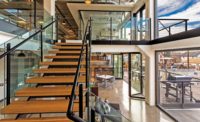Joseph Smith Memorial Building Exterior Renovation
Salt Lake City
Best Project
Owner: The Church of Jesus Christ of Latter-day Saints
Lead Design Firm: FFKR Architects
General Contractor: Jacobsen Construction Co.
Subcontractors: Alpine Caulking Specialties LLC; Cache Valley Electric; Child Enterprises; Eagle Environmental Inc.; Grow Painting Inc.; Raymond Keller Construction; Star Landscape; Weather Tech
The Joseph Smith Memorial Building has been a focal point in downtown Salt Lake City since 1911, when it originally opened as the Hotel Utah. Now owned by the Church of Jesus Christ of Latter-day Saints, the building is home to three restaurants, a theater, a chapel, exhibits, a genealogy center and several banquet rooms.
Over the years, the building’s terra-cotta exterior needed extensive refurbishing. The job required cleaning and repointing all exterior brick, replacing brick mortar, cleaning the building, abating lead-based paint on the metal cornice, repainting railings and metal work and replacing all metal flashings and louvers.
Terra-cotta is hard to work with, and the task was delicate and complicated. In the end, the contractor replaced almost 50% of the terra-cotta and enameled brick on the north, south and west elevations. The original terra-cotta pieces were considered among the most ornate in the Intermountain West. Replacing them was difficult because they were handmade, and thus neither plumb nor square. Each piece varied in size, texture, glaze and shape. The variations made it difficult to replicate the pieces, especially when the material shrank as much as 15% during curing and glazing.
The work required comparisons to other terra-cotta sections of the building to make sure everything matched. Efforts to protect the building’s historical integrity included extensive consulting and collaboration with the original terra-cotta supplier in California.
The project also involved careful removal of lead paint from the building’s projecting metal cornice on the 10th floor. To ensure containment of lead particles, the contractor encased each section of the cornice before sandblasting.
Because the building was in constant use during the project, safety was a prime concern both for workers and the public. Pedestrian pathways were always available and well-lit, and crews created a pedestrian tunnel through the scaffolding during work on the building’s south elevation. The project finished with zero OSHA-recordable incidents and lost-time accidents.
In all, the endeavor took 23 months of meticulous work. But in the end, it created a beautiful new exterior for one of the city’s most treasured buildings.
Related Article: Institutional Work Leads Field of 2017 Best Projects Winners





